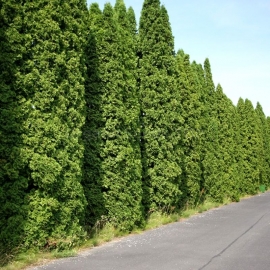


«Fastigiata» Organic Thuja Occidentalis Seeds (Northern White Cedar)
1.78 €
An evergreen tree with fan-like branches and scaly leaves. Unlike the closely related species, Thuja plicata (Western Redcedar), it is only a small tree. Growing to a height of 10-20 m tall with a 0.4 m trunk diameter, exceptionally to 30 m tall.
-
Organic Thuja Occidentalis «Fastigiata» (Northern White Cedar)
An evergreen tree with fan-like branches and scaly leaves. Unlike the closely related species, Thuja plicata (Western Redcedar), it is only a small tree.
Growing to a height of 10-20 m tall with a 0.4 m trunk diameter, exceptionally to 30 m tall and 1.6 m diameter, the tree is often stunted or prostrate. The bark is red-brown, furrowed and peels in narrow, longitudinal strips. The foliage forms in flat sprays with scale-like leaves 3-5 mm long.
The cones are slender, yellow-green ripening brown, 10-15 mm long and 4-5 mm broad, with 6-8 overlapping scales. The branches may take root if the tree falls. Eastern white-cedars found to be growing on cliff faces in Southern Ontario are the oldest trees in Eastern North America and all of Canada, growing to ages in excess of 1653 years old.
How to Grow
Fastigiata Arborvitae will grow to be about 20 feet tall at maturity, with a spread of 8 feet. It has a low canopy with a typical clearance of 1 foot from the ground, and is suitable for planting under power lines. It grows at a slow rate, and under ideal conditions can be expected to live for 50 years or more.
This tree does best in full sun to partial shade. It prefers to grow in average to moist conditions, and shouldn't be allowed to dry out. It is not particular as to soil type or pH. It is somewhat tolerant of urban pollution, and will benefit from being planted in a relatively sheltered location. Consider applying a thick mulch around the root zone in winter to protect it in exposed locations or colder microclimates.
